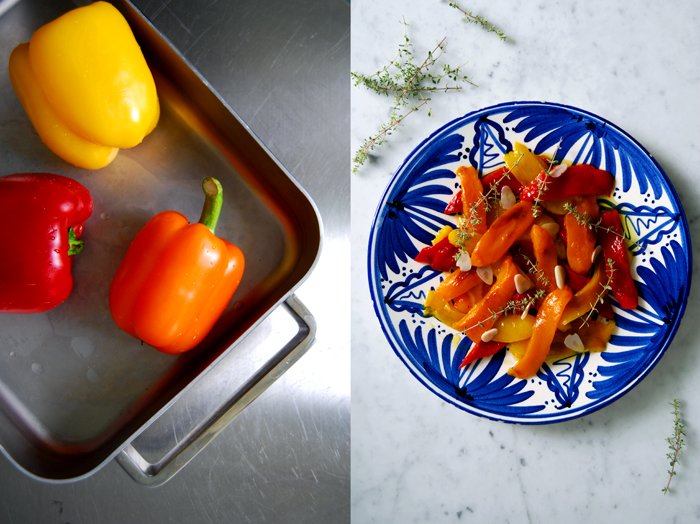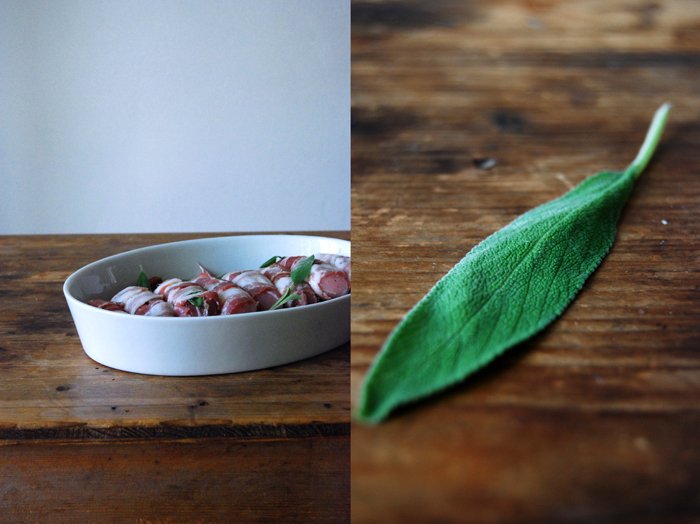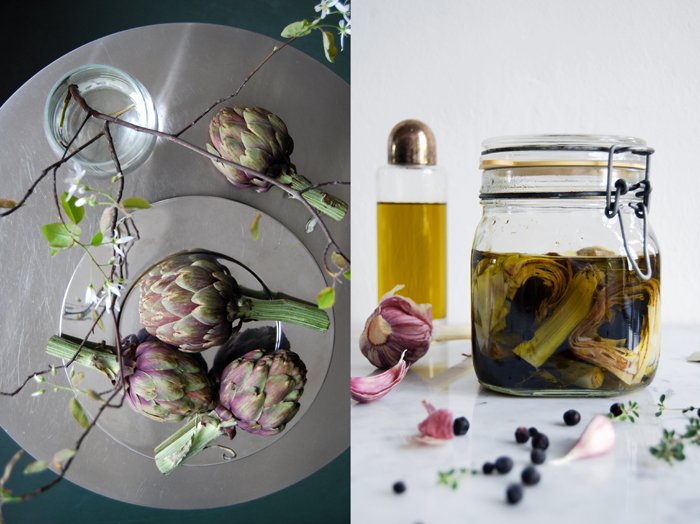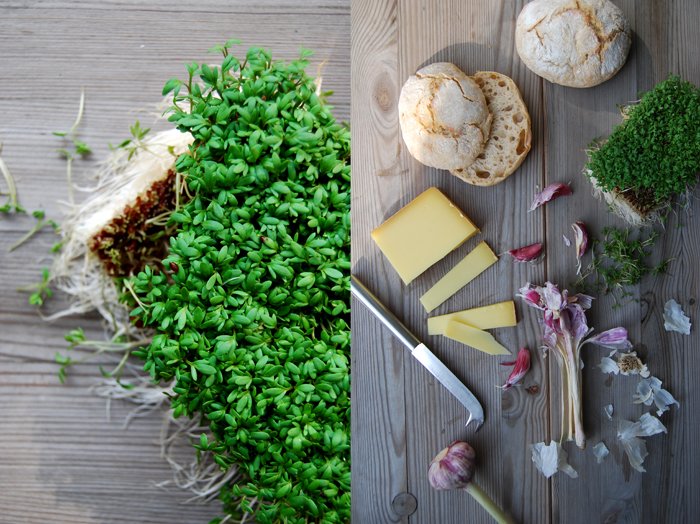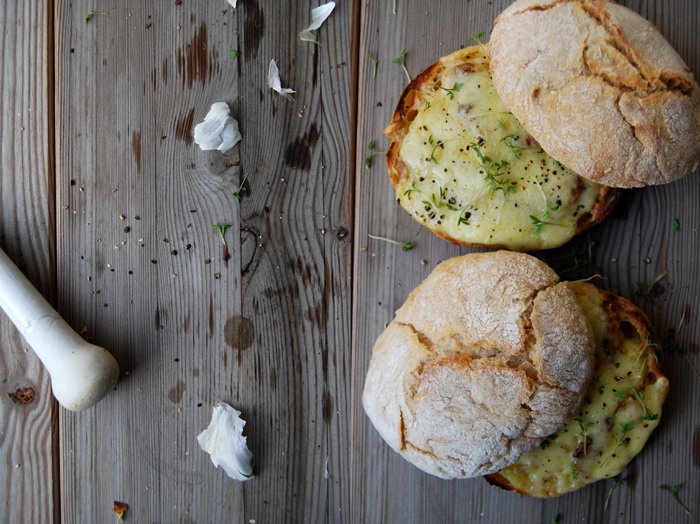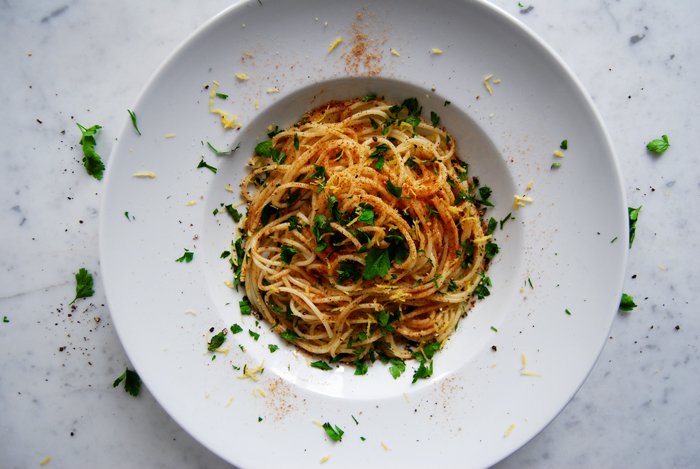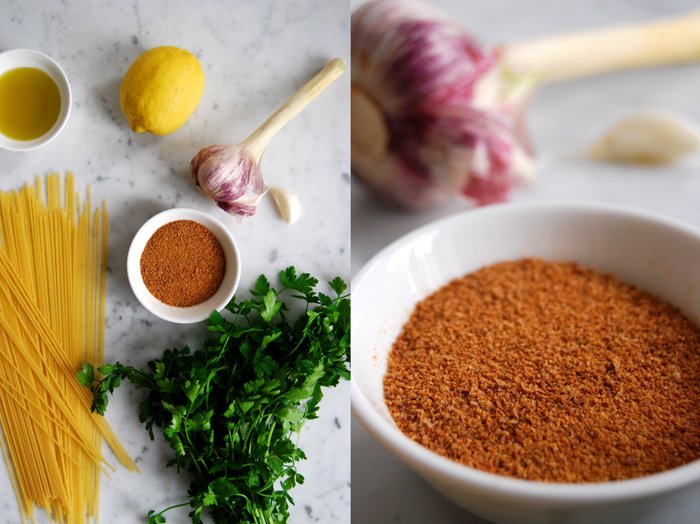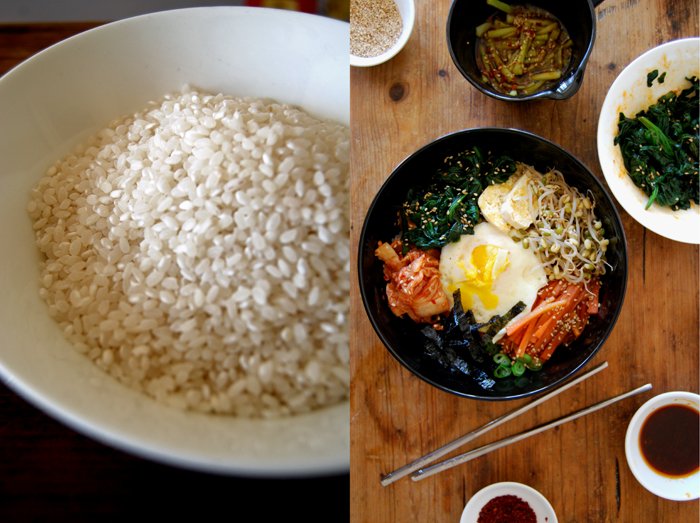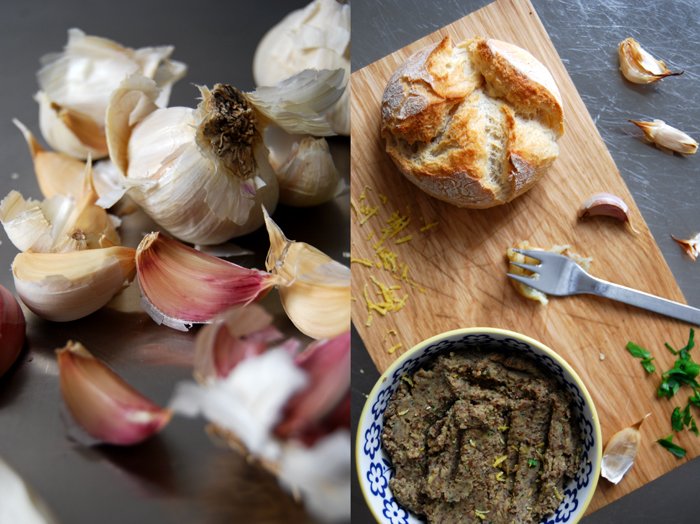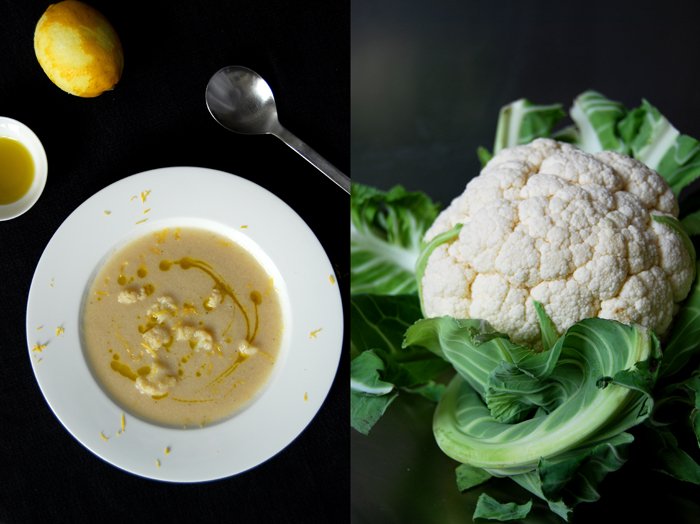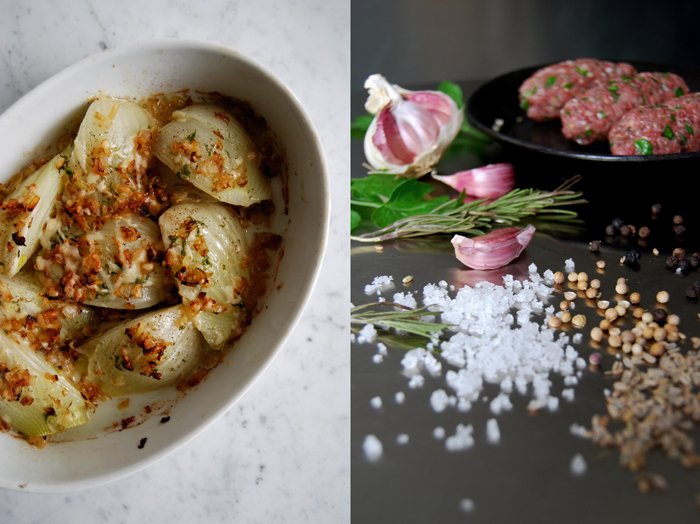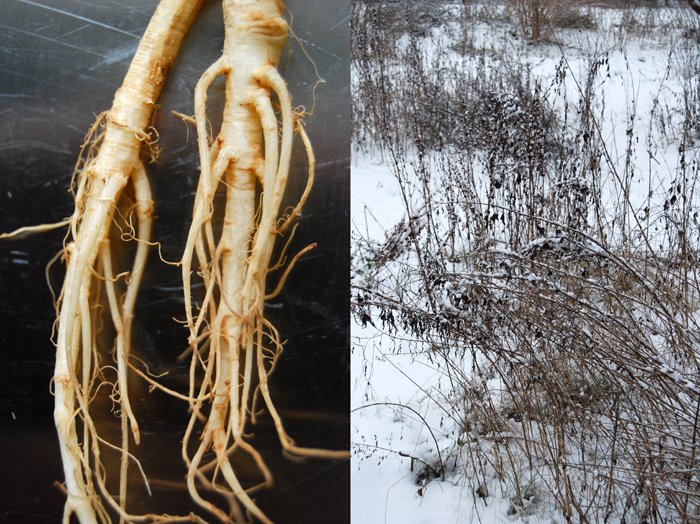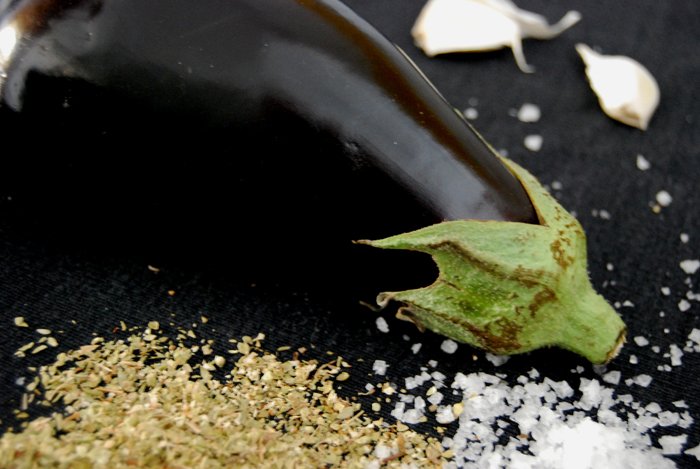Grilled Bell Pepper with Garlic and Thyme
When I see juicy strips of grilled bell pepper on an antipasti platter, colourful in red, orange and yellow, I can barely stop myself from eating all of them (which is unfortunate for my antipasti platter companion). I love this balanced taste of sweet and smokey, it's addictive! There are many ways to do this, some prefer to grill the fruit cut in half, some say you should cook it whole in one piece. Peeling the skin off can be a bit fiddly but it's manageable, there are many suggestions to make this part easier. The latest I heard was to put the grilled bell pepper in a plastic bag and shake it to get rid of the skin although I've never tried it myself.
This is how I grill and peel bell pepper, how I've done it for years and it works perfectly: I put the whole fruit in a baking dish under the grill, turning it as soon as one side gets dark (meaning partly black). When the skin is dark and burst all around, after about 25 minutes, I open the oven, take out the dish and lay a wet kitchen cloth or paper towel over the bell peppers to cover them completely. I wait just a few seconds as they should stay warm and moist for this process. Then, I take out one pepper after the other and pull the skin off with a knife. If you leave them to cool without the moisture it's impossible to peel them without damaging the flesh.
Sometimes I grill a big batch of bell peppers, I cut them in thick strips and keep them covered in olive oil in the fridge for days. Apart from the fact that it is a convenient (and healthy) nibble, it's perfect for an antipasti platter at one of our dinner parties, as a salad or to make sandwiches. This time I grilled only three peppers and marinated them in garlic infused olive oil and fresh thyme. They didn't last very long!
Grilled Bell Pepper with Garlic and Thyme
For 2-4 people you need
bell peppers (red, orange or yellow) 3
olive oil 3 tablespoons
garlic, cut into thin slices, 1 big clove
thyme sprigs 8
In a sauce pan, warm up the olive oil and garlic for 3 minutes on a medium-low heat to infuse the oil, the garlic shouldn't change colour.
Put the bell peppers in a baking dish under the grill and turn them as soon as one side gets dark and starts to burst. I turned them twice, after 10 minutes on each side, I cooked the third side for only 5 minutes. Take the baking dish out and cover with a wet kitchen cloth or paper towel immediately. Wait for 10 seconds, take out one pepper and peel it with a knife. Keep in mind that they are still hot, especially the inside! Cut the peeled fruit in half, take out the seeds and cut the bell pepper into strips.
Pour the olive oil over the bell peppers and sprinkle with the garlic and thyme sprigs (or just the leaves if the sprigs are hard and woody). You can season it with salt and pepper but I left it pure.
Spaghetti with Anchovy Pangrattato, Lemon and Parsley
La dolce vita, I can hear it calling me! I need a holiday, some Mediterranean vibes, the sea that slows down my pace! For now I only have my beloved Mediterranean food but there's only a month between me and a little dolce far niente! Our flights are booked and in four weeks we will be heading South, but my mind is already there, in Malta, our beautiful rock in the Mediterranean Sea. I find myself daydreaming about all the things I will do and eat.
I have a plan, I will enjoy the sea and spend lots of time with our friends and family as I always do but I will also share some of my culinary hotspots with you. Over the years, I found so many delicious restaurants, small producers of olive oil, cheese, bakeries, winemakers and my salt pans in Gozo of course. I met many people who are as passionate about eating and cooking as I am, chefs and Maltese Mamas who have treated their families to years of the most delicious traditional dishes. Soon, I will meet these food lovers, we will talk about food, I will watch them cook and share their recipes with you on the blog. I'm very excited and I can't wait to show you this amazing island, its food and natural beauty!
For now I can only enjoy all the lovely dishes that feed my memories and fit my daydreams, like spaghetti with pangrattato (meaning grated bread in Italian), crisp breadcrumbs fried with anchovies and garlic! I sprinkle it with freshly squeezed lemon juice, crushed black pepper and parsley, a summer meal which couldn't be quicker and easier!
Spaghetti with Anchovy Pangrattato, Lemon and Parsley
For 2 people you need
spaghetti 200g / 7 ounces
dry breadcrumbs 5 heaping tablespoons (if you have some stale white bread left put it in a food processor and turn into breadcrumbs)
anchovies, rinsed, dried and finely chopped, 2-3 big fillets (use 3 if you like a strong fish taste)
garlic, finely chopped, 2 cloves
parsley, finely chopped 1 1/2 tablespoons
lemon 1/2, to drizzle over the pasta
black peppercorns, crushed coarsely
salt
olive oil for frying
Cook the pasta in lots of salted water al dente.
In a heavy pan, heat a splash of olive oil and fry the garlic on a medium heat for 30 seconds. Add the anchovies and fry for a few seconds before you pour in a little more oil, add the breadcrumbs and fry until golden brown and crisp. Divide the spaghetti and the pangrattato between 2 plates and sprinkle with lemon juice, black pepper and parsley. Season with salt, carefully as the anchovies are very salty.
Rabbit wrapped in Sage and Bacon roast on Rhubarb
Sweet and sour rhubarb, salty bacon and aromatic sage wrap my juicy pieces of rabbit in a delicious composition of spring flavours. You could use pork fillet in this recipe as well but I like rabbit meat, it's tenderness and unique taste. We often eat it when we're in Malta where rabbit is so popular that it became the national dish. Be it as a Mediterranean stew with olives, tomatoes and wine, often cooked together with pork for a stronger aroma, or in a pie, I've enjoyed some of the best rabbit meals on this island!
Rabbit meat isn't very challenging to cook as long as it's kept moist and not overcooked. The little packages of sage and bacon in my recipe infuse the meat with their flavours but also keep it juicy. The steaming rhubarb roasting under the meat has the same effect. Its juices add a fruity taste to the meat and make sure that it doesn't dry out while it's cooking.
Rabbit wrapped in Sage and Bacon roast on Rhubarb
For 4 people you need
rabbit, without bones, 500g / 1 pound for 8 portions (I bought rabbit back and legs, the fillets from the back were the easiest to prepare)
rhubarb, cut into 5cm / 2" pieces, 500g / 1 pound
granulated sugar 3 tablespoons
garlic, thinly sliced, 3 cloves
fresh sage 16 leaves
bacon 8 slices
white wine 75ml / 2.5 ounces
olive oil 2 tablespoons
salt and pepper
Set the oven to 210°C / 410°F. My oven has a Rotitherm roasting setting which works perfectly for this recipe.
Cover the bottom of a baking dish with the rhubarb mixed with sugar. Season with salt and pepper.
Divide the rabbit in 8 portions, season with salt and pepper and wrap each portion in a slice of bacon together with 2 leaves of sage and 3 slices of garlic. Place on top of the rhubarb and pour the wine and olive oil over it.
Bake in the oven for 20 minutes, pouring some of the juices over it from time to time. For the last 3 minutes sprinkle the bacon with some sugar.
A warm Salad with Artichokes in Vermouth
Artichokes seem to follow me in the past few weeks, even when I don't buy them they end up in my kitchen. I got a bag full of beautiful purple baby artichokes as a gift, the tiniest I've ever seen. A friend of mine had bought too many and knowing that I use everything that finds its way into my space she was happy to pass them over to me. I had already made plans for dinner but the vegetables couldn't wait a day longer. When I looked at them, a warm salad came to my mind, a little snack in between. I imagined them sautéed and deglazed with vermouth and some parsley on top, so I brought out my pan and started the cooker.
As a starter for 4 you need 6 small baby artichokes. Cut off the artichoke stem if it’s too woody and pluck the hard outer leaves. Cut the artichoke’s tip off (1/3 – 1/2 of the artichoke), quarter them and scoop out the hairy choke. Keep the prepared artichokes in a bowl of cold water and the juice of half a lemon while you’re finishing the rest.
Sautée the prepared artichokes in a large heavy pan in a dash of olive oil and 2 tablespoons of butter for about 5 minutes together with 1 thinly sliced clove of garlic. Deglaze with 75ml / 2.5 ounces of vermouth and season with salt and pepper. Add 75ml / 2.5 ounces of water and 1 tablespoon of freshly squeezed lemon juice and let them simmer on a medium heat for about 10 minutes until al dente. Sprinkle with roughly chopped parsley and season with salt and pepper to taste.
Gratin with Cauliflower and Garlic Mashed Potatoes
This is a recipe my father used to make for us when we were children. We all loved it because of the cheese and mashed potatoes! I still do as it's one of the few dishes made with cauliflower that I really like.
When I wrote about my ginger, lemon and cauliflower soup I mentioned that I don't use this pretty white cabbage so often in my kitchen, I only like it in a few combinations. I don't have anything against its unique taste, it just needs the right treatment to bring out its sweet side. The mashed potatoes are a good choice, seasoned with nutmeg which I also use for the cauliflower to refine its taste, they are a good match. I didn't want to disturb the mild flavours in the gratin so I picked a soft cheese for the crunchy crust, not too ripe and overpowering. I used a hard Gouda, this Dutch cheese melts well and develops a nice crust under the grill, it's also the cheese my father used for this meal.
This recipe is very simple to prepare, a whole cauliflower cooked in one piece, pushed into creamy mashed potatoes and baked with cheese to a golden gratin. If you need a quick dinner for a handful of people, this is the perfect choice!
Gratin with Cauliflower and Garlic Mashed Potatoes
For 4 people you need
a whole cauliflower, around 700g / 25 ounces
potatoes, peeled, 650g / 23 ounces
garlic, in its skin, 3 big cloves
milk 200ml / 7 ounces
butter 50g / 2 ounces
nutmeg, freshly ground
salt and black pepper
hard cheese (Gouda, Emmentaler or cheddar), thinly sliced, 100g / 3.5 ounces
Cook the potatoes together with the garlic in salted water for 20 minutes. Rinse the potatoes under cold water for a few seconds and peel the garlic. Mash the potatoes together with the garlic, milk and butter, whisk and season with salt, pepper and nutmeg to taste.
Cook the cauliflower in lots of salted water al dente (around 10 minutes), it should be soft with bite without falling apart.
Scrape the mashed potatoes into a baking dish, put the cauliflower on top and push it down. Season the cabbage with salt, pepper and nutmeg and cover it with the cheese. Bake under the grill for a few minutes until golden brown, bubbly and crisp, slice like a cake and serve immediately.
Preserved Artichoke Hearts with Spices and Thyme
I've been wanting to marinate artichokes for so long, ever since I had my own kitchen in fact, which is quite a while ago. I took my time and over the years I discovered the advantages of a pantry packed with jars of homemade jams, chutneys, preserved lemons and fruits but now I want to see some artichoke hearts cooked in wine and vinegar, with lots of spices on my shelves as well. I love to fill this space with all the jars that make my favourite food so handy and always available, I don't have to worry about industrial preservatives which are banned in my kitchen.
The process of preserving has a wonderful side effect, it's so relaxing! I understand why my grandmother used to have a room in her cellar packed to the ceiling with preserving jars and bottles, cherries, pears and plums, German apple purée, gherkin, jams, so much that even my big family didn't manage to eat everything that she produced. I imagine that she enjoyed preserving food as much as I do now, standing peacefully in her kitchen, keeping an eye on the bubbling and steaming food in the pots. When I'm done with cooking and have filled my culinary products into the jars and line them up on a table, I feel so satisfied and rewarded for the work I've done, it's truly therapeutical!
Artichoke hearts preserved in olive oil are great on bread sprinkled with parsley, on crostini or pizza, mixed with pasta or in a risotto. You could also fry them together with your omelet, mix them into a Mediterranean salad or enjoy them pure on a summery antipasti platter.
Preserved Artichokes Hearts
For 6 artichoke hearts preserved in an 800ml jar you need
baby artichokes 6
water 900ml
white wine 350ml
white wine vinegar 150ml
garlic, quartered, 2 cloves
bay leaves 2
black peppercorns 8
juniper berries 5
thyme 8 small sprigs
salt 1 teaspoon
lemon 1/2, to prevent the artichokes from turning brown
olive oil to fill the preserving jar
spirit to sterilise the rim of the jar
Peel the artichoke stems, if it isn't soft but woody you have to cut it off. Pluck the hard outer leaves and cut the artichoke's tip off (1/3 - 1/2 of the artichoke), just the soft parts of the leaves should be left. Loosen the hairy choke with a knife and scoop it out with a spoon. Keep the prepared artichoke heart in a bowl of cold water and the juice of half a lemon to avoid it discolouring while you're finishing the rest.
In a large pot, bring all the ingredients to a boil, add the artichoke hearts and cook for 10 minutes.
Sterilise the preserving jar in boiling water for 5 minutes. Take it out, let it dry for a few minutes and dip the rim of your jar in the spirit and wash out the lid with the alcohol as well.
Drain the artichokes and put them in the sterilised jar, fill with olive oil till covered and add some of the spices and thyme sprigs. The jar should be filled with oil to the top! Close the jar, keep in your pantry or enjoy immediately.
Roast Garlic and Gruyère Sandwich
Garlic roasted in its skin is one of these things I can never have (or make) enough of. No matter how many of these little cloves I throw into the hot oven, I always feel like I could have made more. They cook in their delicate peel like in a little parchment pouch, steaming, softening and unfolding all of their wonderful flavours. It tastes less spicy than raw garlic but yet so aromatic, almost sweet and the texture is smooth, a bit oily. It's a great spread on bread!
Garlic is considered a natural antibiotic which has lots of positive effects on the body. It strengthens the immune system, stops free radicals and slows down the aging process. A tiny bulb that does a lot of good for our body! I strongly believe in the healing and strengthening powers of natural and good quality food. This is one of the reasons why I buy organic food as much as possible. I want natural food which is kept natural, no GMOs, no pesticides. Food in harmony with nature and not fighting against nature. A few years ago I started to drink organic green tea with freshly squeezed lemon juice every morning, since then I haven't had a single cold. It’s my natural booster for my immune system.
There must be something in garlic that my body loves and when it comes to roast garlic I feel like I could eat it with a spoon, in strong doses like in this sandwich made with 14 cloves of garlic for just 2 buns! I baked medium sized cloves of garlic in their skin in a 210°C / 410°F hot oven for about 12 minutes until golden and soft (you can cover them with aluminum foil if they start to get too dark). They were so soft that I could mash them with a fork, I just added some salt and spread the paste on the buns. I put a couple slices of Swiss Gruyère cheese on top (120g / 4.5 ounces for 4 halfs) and let them melt under the grill for 1-2 minutes until golden brown. I finished my sandwich off with crushed black pepper and some watercress sprinkled on top.
An oily and dense Ciabatta bread would have been good too but when I saw the Swiss Buns at the bakery which have a similar texture to the Italian bread I thought they would match the Gruyère cheese perfectly, it became a delicious and healthy Swiss sandwich!
Sicilian Spaghetti with Bottarga di Tonno
Marzamemi! This is the name of a picturesque fishing village in southern Sicily in the Syracuse region. It's right by the sea, with two churches - an old and a new one - both dedicated to the village's patron San Franceso built around the historic piazza which is, as in every Mediterranean village, the lively centre especially at night.
Two years ago we spent an evening in Marzamemi, strolled through the narrow alleys, between the old limestone houses where fishermen used to live. We passed a beautiful artisan market which was still open at night and enjoyed the sight of all the restaurants which had placed their long tables outside in the piazza where families already filled the air with laughter and the delicious smell of seafood. We couldn't wait any longer to join them and went straight to the restaurant at the sea where our table was waiting for us, but as we wanted to sit down we spotted an old storehouse with a big, open gate and people walking in and out. Curiosity was still stronger than our appetite, so we took a look.
We went inside a huge hall piled high with fish products, mainly made of bluefin tuna but also anchovies, sardines, mackerel, and swordfish. I discovered food I had never seen before, tuna salami for example, I had to buy it! It tasted interesting, salty, something I would have to eat a few times and try out a few combinations to get used to it. They also sold the famous Bottarga di Tonno, the dried roe pouch of bluefin tuna. If it's in one piece, you slice it thinly over spaghetti, grated you sprinkle it over a quick pasta dish. Its taste is distinct and salty, it comes from a fish with a strong flavour and you can taste it!
I haven't eaten it since my last visit to Sicily so I was happy to finally open a jar of grated Bottarga di Tonno again and mix it with my pasta. I like to add some lemon (juice and zest), garlic, parsley and coarsely crushed black pepper.
Spaghetti with Bottarga di Tonno, Lemon and Parsley
For this meal I suggest you warm up the plates in the oven.
For 2 people you need
spaghetti 200g / 7 ounces
olive oil 6 tablespoons
garlic, cut in half, 2 cloves
grated Bottarga di Tonno 4-6 heaping teaspoons
freshly squeezed lemon juice 1 tablespoon
lemon zest 2 teaspoon
fresh parsley, chopped, 4 heaped tablespoons
salt and coarsely crushed black peppercorns
Cook the pasta in lots of salted water till al dente.
Heat up the oil in a sauce pan, add the garlic and take the pan off the heat, let it infuse the oil for a couple minutes and add the lemon juice.
After the pasta is mixed with the warm oil and divided between the plates, sprinkle with parsley, lemon zest, pepper and salt and add the bottarga di tonno to taste.
Spaghetti with Crisp Bacon, Tomatoes and Fennel Seeds
A fruity tomato sauce with spaghetti together with a glass of red wine can never go wrong. To add some crisp bacon and fennel seeds makes it even better! I don't even remember all the different variations on tomato sauces I've made in my life but this one is really good, and quick to prepare. For days I've been wanting to make a Sauce Bolognese but I never found the time as it needs to cook for an hour. This one here is meaty as well but only needs 10 minutes on the cooker. The bacon (I used lots of it!) makes it hearty and the aromatic spice adds a Mediterranean touch to it.
For 2 people I used 100g / 3.5 ounces of bacon, cut into little cubes and fried until golden and crunchy. I fried 1 tablespoon of fennel seeds, 2 cloves of garlic (crushed) and 1 small dried chili together with the meat for about 2 minutes before I added 400g / 14 ounces of tinned tomatoes (crushed), 1/2 teaspoon of sugar, salt and pepper. The sauce simmered on medium temperature for 8 minutes while the spaghetti (200g / 7 ounces ) cooked in lots of salted water until they were al dente.
If you prefer a vegetarian sauce just leave out the bacon and add a bit more olive oil to fry the fennel seeds, I make that sometimes and it's great, too.
Yu-Kyong's Bibimbap, a traditional Korean treat
A few weeks ago I met a very sweet couple from Norway, Lena and Knut, we sat opposite each other at a supper club and started talking. Days later I found out about their wonderful blog Teak Tray Weekdays where they share little treasures of their daily life in Trondheim and their traveling trips, I got peacefully lost in their stories. When Lena asked me if I would like to cook something together with them I was very happy. I liked the idea of the three of us cooking the same meal in different kitchens in different countries and with different recipes. I let them choose what we would cook and they suggested Bibimbap. They had just been to Berlin and enjoyed this Korean speciality at a restaurant so much that they wanted to cook it at home.
At first, I wasn't sure about my approach to this meal. I had never cooked Korean before and I usually need an experience, a memory, a story, taste, something that opens the door to a new culinary experience. I asked my oldest friend Yu-Kyong for help, we lived next to each other through our whole childhood, she has Korean roots, her father grew up in North Korea and her mother in the South. She lived in Germany all her life but her mother cooks Korean for the family and introduced her daughter to the traditional recipes, like Bibimbap.
When I asked Yu-Kyong to write down the recipe so that I could buy all the ingredients she told me that this wouldn't work, we would have to go shopping together. We met at an Asian market and she gave me an introduction to Korean cooking. She explained the necessary spices, mixtures, spice pastes and preparations to me, all in between hundreds of boxes, tins and bottles of food, freezers stuffed with tiny crabs, octopus and fish. The scent of a different world in my nose, visually overwhelmed, I tried to keep up with her. She told me about the different flavours and qualities of sesame oil, I learnt how to cook sticky rice properly, which cutlery I have to use (a metal spoon and metal chopsticks, not wooden!) and so much more. Basically, a one hour crash course on Korean cooking, in the middle of an Asian market, typing everything more or less precisely into my phone, not to forget a single detail.
I got home with bags of vegetables, Kimchi, roasted seaweed, Obok Gochujang hot pepper paste, many colourful tins and boxes. I bought the first tofu of my life and I felt happy and finally prepared for this new cooking experience.
Here's a quick description of Bibimbap, it's a one pot meal, rice at the bottom and steamed vegetables mixed with a sesame oil and soy sauce dressing on top. I steamed spinach, sprouts and carrots and added strips of seaweed, Kimchi (spicy fermented cabbage), fried tofu and eggs. The spinach is glazed with the special Bibimbap Gochujang sauce which is mixed into the rice as well. I made a traditional cucumber salad on the side, mixed with sesame oil and soy sauce, sprinkled with chili powder and toasted sesame seeds.
This meal needs good preparation before you mix everything together, it's a ceremony of pure tastes mixed with the strong flavour of good quality sesame oil and the spiciness of Gochujang. When you make your own Bibimbap you should allow some extra time to enjoy the cutting, steaming and mixing, it's meditative. I learnt that this is not a warm meal, the rice and egg (which I fried in the end) have to be warm but the steamed vegetables can be cold.
Vegetable Bibimbap and Cucumber Salad
For 3-4 people you need
sticky rice, rinsed, 170g / 6 ounces
soybean sprouts, steamed for 1-2 minutes, a handful
spinach, steamed for 1-2 minutes, 250g / 9 ounces
carrot, cut into julienne, steamed for 1 minute, 1-2
tofu, cut into 0.5cm / 1/4" slices, 200g / 7 ounces
Kimchi 6 tablespoons
spring onions, cut into thin slices, a small handful
Korean roasted seaweed, cut into strips, 5 sheets
organic eggs 3-4
sesame seeds, toasted in a pan for a couple minutes on medium heat, 2 tablespoons
cucumber, peeled, cut in half, without the seeds and soft parts, a 15cm / 6" piece for the cucumber salad
dried chili spice for the cucumber salad, 1/8 teaspoon
Gochujang hot pepper paste 1 tablespoon
sesame oil 6 tablespoons
soy sauce 5 tablespoons
sugar
garlic, crushed, 4 cloves
Whisk the following ingredients for the sauce used for the steamed soybean sprouts, carrots and cucumber salad
4 1/2 tablespoons of the sesame oil
3 tablespoons of the soy sauce
1 1/2 tablespoons of sugar
3 small crushed cloves of garlic
Whisk the following ingredients for the Bibimbap sauce (used for the steamed spinach and the rice)
1 tablespoon of the Obok Gochujang hot pepper paste
1 1/2 tablespoons of the sesame oil
2 tablespoons of the soy sauce
3/4 tablespoon of sugar
1 small crushed clove of garlic
Cook the rice in a pot filled with water and a pinch of salt (the water should be 2cm / 1" above the rice) for 12 minutes, on medium heat, keeping the lid closed. If the rice is still hard and didn't soak all the water, keep it on the heat for a couple more minutes. When it's done, keep the rice covered and set aside.
For the salad, cut the cucumber into strips, mix with 1/3 of the dressing (not the Bibimbap sauce) and sprinkle with some sesame seeds and the dried chili spice. The cucumber salad is served as a side dish, not on top of the Bibimbap like the rest of the vegetables.
Glaze the steamed soybean sprouts with 1/3 of the dressing (not the Bibimbap sauce) and the steamed carrots with the rest of the sauce, sprinkle both with sesame seeds.
Mix the steamed spinach with 4 teaspoons of the special Bibimbap sauce (keep the rest of the sauce to mix with the rice).
Fry the tofu in a little sesame oil for 2 minutes until golden, turn gently and fry on the other side. When it's done, set it aside.
Fry the eggs, leaving the egg yolk soft.
Put the rice in a large bowl and the spinach, carrots, sprouts, Kimchi, spring onions, tofu and seaweed on top, arrange them in a circle next to each other. Place the fried eggs in the middle and sprinkle everything with sesame seeds.
When you serve the Bibimbap at the table, you can either mix everything in the bowl together with the rest of the Bibimbap sauce or divide it between the plates and add some sauce to it (that's how I did it).
Broccoli Pesto with Spaghetti and Sun-dried Tomatoes
Finally pesto! I love it, bunches of basil, parsley, chopped green or black olives, sun-dried tomatoes, capers, garlic, anchovies mixed with olive oil, nuts or cheese. There are endless possibilities to bring one of the most satisfying meals onto the table, pasta with pesto. It's so simple yet so special! When I make pesto I just follow my mood and appetite, picking what the kitchen herbs on my window sill offer and mixing it together with the Mediterranean fruits and vegetables preserved in salt or oil I keep in jars in my fridge. Sometimes I mix fresh vegetables in as well, like green asparagus or broccoli.
Today is a broccoli day! I cook it al dente, put some of it in a blender and mix it with parsley, ginger, garlic, anchovy, lemon juice and olive oil. Some of the water used to cook the broccoli stirred in makes the pesto nice and smooth, it's lighter than using just olive oil. When the warm spaghetti has been mixed with the broccoli pesto, I sprinkle some broccoli, sun-dried tomatoes and red chili on top. There are lots of different flavours in this pesto but they blend in perfectly and allow the broccoli to show its fresh side.
Broccoli Pesto with Spaghetti and Sun-dried Tomatoes
For this meal it's best to warm the plates in a 75°C / 165°F warm oven for a few minutes. I prepare them while the pasta is cooking.
For 4 people you need
spaghetti 400g / 14 ounces
broccoli, florets and the soft part of the stem, 450g / 16 ounces
water used to cook the broccoli 50ml
sun-dried tomatoes, cooked in a little water for 2 minutes to wash off the salt, dried and chopped, 1 1/2, for the topping
water used to cook the sun-dried tomatoes, 3 tablespoons
fresh parsley, chopped, 3 heaping tablespoons
garlic, crushed, 1 big clove
ginger, grated, 1/2 teaspoon
anchovy preserved in salt (optionally), rinsed and dried, 1
lemon juice 2 teaspoons
olive oil 3 tablespoons
salt and pepper
fresh red chili, chopped, 1, for the topping
In a large pot, bring water to the boil, add some salt and cook the broccoli al dente. Keep 1/3 of the cooked florets, cut into bite sized pieces and set aside.
Cook the spaghetti al dente.
Put the rest of the broccoli (florets and stem cut into pieces) in a blender and mix together with some of the water used to cook the broccoli and sun-dried tomatoes. Add the parsley, garlic, ginger, anchovy, lemon juice, olive oil and mix well. Season the pesto with salt and pepper but keep in mind that the tomatoes used for the topping will add some saltiness as well.
Arrange the spaghetti and the pesto on big plates and sprinkle with the chopped tomatoes, pieces of broccoli, chili and some more black pepper.
A Sandwich with Lemon Lentil Mousse and Roast Garlic
The legume section in my pantry is overflowing, it's time to empty some lentil boxes! My plan is to make a smooth lentil mousse enhanced with parsley, lemon and garlic, to spread on sandwiches and to eat together with raw vegetable sticks. I prepare a big bowl as we'll have my brother in law over for the next couple of days. When guests stay with us, I like to have some food ready in the fridge, easy nibbles and snacks that everyone can enjoy whenever they feel like, but first I'll need the mousse for my Sandwich Wednesday.
Besides the lemon and parsley aromas, the garlic plays an important role. I don't leave it plain and raw, I roast it, golden and sticky, almost sweet. I bake big, fleshy cloves in their skin and after 10 minutes in the oven they turn into a delicious paste. They taste so good that I throw a couple more into the oven, as an extra topping. Squeezed with a fork I lay the warm and juicy garlic on top of the lentil spread. This is such a great combination, the nuttiness of legumes together with the sourness of the lemon juice and zest, the aromatic parsley and the sweet and spicy garlic. I've made a few variations on this lentil mousse already, but this one is the freshest!
Lemony Parsley Lentil Mousse and Roast Garlic on a Sandwich
For the sandwiches you need white buns with a nice crust, crisp and crunchy. I made lots of mousse, it stays fresh for a few days. It's also great as finger food for parties, on slices of bread or served together with vegetable sticks!
lentils 350g / 12.5 ounces (I use a small type which doesn’t need to soak overnight)
bay leaf 1
fresh parsley, chopped, the leaves of a medium bunch plus more for the topping
freshly squeezed lemon juice 5 tablespoons
lemon zest 3 teaspoons plus more for the topping
olive oil 50ml
salt 2 1/2 teaspoons
black pepper
garlic, 12 big cloves in their skin (6 for the mousse, 6 for the topping)
Cook the lentils in 1 liter of water together with the bay leaf for 20 minutes or until they are done. Don’t season with salt yet or the lentils will stay hard. Take out the bay leaf and drain the lentils.
Set the oven to 220°C / 430°F (I used the Rotitherm roasting setting) and roast the cloves of garlic in their skin for 12 minutes or until they are soft. Peel the garlic and squeeze with a fork.
Mix the lentils in a blender to a smooth paste together with the parsley, lemon juice and zest, olive oil and half of the garlic. Season with salt and pepper to taste.
For the sandwiches, cut the buns in half, spread the lentil mousse on one side and lay 1 or 2 squeezed, roast garlic on top. Sprinkle with some parsley and lemon zest and close the bun.
Carnival and a Cauliflower Soup with Ginger and Lemon
A couple weeks ago I wrote about our traditional family feast, a time when we all meet at my mother's house in the countryside to celebrate carnival. It's always silly, loud and involves lots of good food. The festive highlight is the making of our Berliner which involves each family member. A Berliner is a sweet speciality which looks a bit like a doughnut without a hole. It’s made of yeast dough, filled with jam, deep fried in vegetable shortening and sprinkled with cinnamon icing sugar. The jam filling changes with the years, a few weeks ago I filled mine with blueberry jam which became my favourite (for now), they tasted divine! The reason I made them at my home without my family before carnival, was a blog tour I was asked to joined. I decided to share our "Berliner" family tradition. I made them on my own for the first time in my life, they were as good as at my mother's but it's more fun with family and friends.
In the end it turned out to be (subconsciously) a wise choice as this carnival will be different. This year there is neither a family feast nor a Berliner to enjoy, for us it's soup instead. A wisdom tooth got in our way and needed to come out quick. Needless to say, a jam filled Berliner isn't the appropriate food in a situation like this, porridge and soup is more like it!
I have a big, beautiful cauliflower in the kitchen, a cabbage I don't use so often but in a velvety soup it shows its finer qualities. The sweet taste and smooth texture is great for puréed soups. I don't add any cream, just broth, onion, garlic and some tangy flavours, lemon and ginger. A piece of ginger simmers together with the cauliflower in the broth before I season it with grated ginger to taste. I add the lemon's juice and zest when the soup is done, arrange it in plates drizzled with some good olive oil and sprinkle some more lemon zest on top. I'm impressed, it's still smooth but fresh!
Last week I told you that eat in my kitchen was nominated for The Kitchn's Best Daily Read Cooking Blog Award 2014. Food52 won the award but I want to thank you all for your support and all your votes, with your help eat in my kitchen reached the final!
Ginger Lemon Cauliflower Soup
For 4 people you need
a big cauliflower, rinsed and cut into 5cm / 2" pieces, around 750g / 1.5 pounds (weight without stem)
vegetable broth 1500ml
onion, chopped, 1
garlic, cut in half, 1
bay leaf 1ginger, thumbnail sized piece plus 1 teaspoon grated
lemon juice 1 tablespoon
lemon zest 1 teaspoon
salt and black pepper
olive oil for frying and topping
In a large pot, fry the onion and garlic in a little oil until golden and soft. Add the cauliflower, bay leaf, the piece of ginger and broth and bring to the boil. Cook for 10 minutes or until the cauliflower is al dente. When it's done take out the bay leaf and ginger and put a few smaller pieces of cauliflower (a small plate full) aside before you mix the soup in a blender. Season with salt, pepper, the grated ginger, lemon juice and zest and put the cauliflower pieces back into the smooth soup. When you arrange the plates, drizzle some good olive oil on top and sprinkle with some lemon zest.
Homemade Sausage with Herbs and Spices and Baked Fennel with Parmesan
Our last visitors from Malta brought some of my favourite sausages along, coarse Maltese pork sausage stuffed with lots of spices and garlic. The kind that you can use to spice up a whole pot of soup. When it comes to sausage that's exactly what I like! When I'm in Malta I fry them for breakfast without their skin and cut in half, like a burger, some fried zucchini (qarabaghli in Maltese) on the side and and I'm prepared for a day on the beach.
The gift from Malta inspired me to make my own sausages, but without skin from the start. I make mine like burgers without egg and bread (apart from a tablespoon of breadcrumbs) and with pork and beef unlike the original. Most importantly they are enhanced with plenty of rosemary, parsley, coriander and fennel seeds (luckily I still have some left from Malta to keep it even more authentic) and my coarse sea salt from Mr. Cini's salt pans in Gozo, Malta's sister island. Spices and salt from other parts of the world will work as well, I just like to add the nice memories and to me, they taste best. As fennel already has such an importance in this meal I add the bulbs as well, baked in the oven with onions, garlic and parmesan. It's the right addition to my Mediterranean sausages which I fry first before I deglaze them with a splash of white wine. This makes a thick sauce of juices, delicious together with the meat and the vegetable.
Homemade Sausage with Herbs and Spices and Baked Fennel with Parmesan
This makes a dinner for 3-4.
For the sausage
minced beef 300g / 10.5 ounces
minced pork 300g / 10.5 ounces
dry breadcrumbs 1 tablespoon
fresh parsley, chopped, a medium bunch
fresh rosemary, chopped roughly, 1 teaspoon
coriander seeds, ground in a mortar, 1 tablespoon
fennel seeds, ground in a mortar, 3/4 tablespoon
black peppercorns, ground in a mortar (coarsely), 1 tablespoon
garlic, crushed, 2 large cloves
coarse sea salt 1 1/2 teaspoons
white wine for deglazing
olive oil for frying
Mix the ingredients well and shape thick sausages. Heat some olive oil in a large cast iron (or heavy) pan and fry the sausages on medium heat until all sides are golden brown. Deglaze the sausages with a splash of wine so that the bottom of your pan is covered, the liquid shouldn't evaporate completely. Turn down the heat, scrape the juices off and close the pan with a lid for 1-2 minutes until the sausages are done inside.
For the baked fennel
large bulbs of fennel, quartered and blanched together with 1/2 lemon for 8 minutes, 2 bulbs (keep the green of the fennel bulbs uncooked and chopped for the topping)
medium onions, chopped, 2
garlic, crushed, 2 cloves
olive oil
Parmesan, grated, 3 tablespoons (you can add more if you like)
salt and black pepper
Set the oven to 200°C / 390°F (I used the Rotitherm roasting setting) and brush a medium sized baking dish with olive oil.
Fry the onion and garlic in a little oil on medium heat until golden brown.
Put the fennel in the baking dish and sprinkle with olive oil and the green of the fennel. Season with salt and pepper, add the fried onions and garlic and cover with parmesan. Bake for 10 minutes until the cheese is golden brown and crisp.
Thai Soup and Beef
The past couple of days have brought a lot of snow, turning the world outside into a winter wonderland. Everything is covered by a soft white blanket, which is true magic to me! It looks different, sounds different and it even smells different. Two days ago I had time for a short walk so I went down the road to a tiny park that looks a bit like a secret garden. It's my city hideaway as it seems to leave the noise and bustle outside as soon as you enter the iron gates. The trees and bushes were covered in snow and I had my camera with me, luckily, so I could take some of these wonderful impressions home with me and share them with you.
After walking for a while I started to feel cold and I got in the mood for a warm, spicy broth, a Thai soup. I have all sorts of broth in my freezer. Every few weeks I cook a few litres of vegetable broth to use for soups and risottos, but I also have duck and pheasant broth in stock at the moment. When you have a strong broth you are already well on your way to a good soup. I warmed up the duck broth and added some lemongrass, ginger, fresh chili and coriander. I was really hungry, so I decided to throw in some pointed cabbage and some tiny meatballs mixed with the spices. The meatballs weren't bigger than walnuts, after cooking in the soup for 5 minutes they were done, the cabbage needed even less. If you prefer the vegetarian version just leave out the meat, which is what I often do. Either way, this soup is a perfect treat for this cold season, you can be sure you will feel warm, strong and refreshed afterwards!
Thai Soup with Meatballs
For 2 people as a main or for 4 people as a starter you need
broth 1500ml
pointed cabbage, sliced thinly, 250g / 9 ounces
ground beef 400g / 14 ounces
fresh ginger, thumb sized piece, 1/3 sliced thinly, 2/3 grated
garlic, crushed, 2 cloves
coriander roots, ground in a mortar, 2-3
coriander leaves, a handful
fresh chili, sliced thinly, 1
lemongrass, peeled and cut into thin slices, 1
salt and black pepper
Mix the coriander roots, the grated ginger, the garlic and a generous amount of ground black pepper in a mortar and grind to a smooth paste. Mix the paste together with the beef, half of the coriander leaves (chopped) and a teaspoon of salt. Form little walnut sized balls with a teaspoon.
Season the broth with salt and pepper to taste, add the slices of ginger and lemongrass and bring to the boil. Cook the meatballs in the broth on medium heat for 4 minutes. Keep the lid closed. After 4 minutes, add the cabbage and cook for another 2 minutes. Serve in deep bowls topped with the chili slices and the rest of the coriander leaves.
White Pizza with Spinach and Ricotta
A few years ago curiosity got the better of me and I tried a "white pizza" at one of my favourite pizza restaurants. White pizza is made without tomatoes and I didn't quite know what to expect. I had my virgin white pizza moment with a spinach and ricotta topping and all my reservations melted away after the first bite. Lighter and with more space for the single ingredients, the absence of tomato sauce didn't lessen that feel good pizza pleasure.
I wrote about my Sunday pizza tradition a few weeks ago and yesterday was no exception. It has been ages since my last white pizza and, as it's been on my mind for a while, I bought some crisp winter spinach and ricotta. To finish it off I added some olive oil infused with garlic and some crushed black pepper. The dough was light and crisp, it soaked some oil, but not too much, a bit like a Focaccia. The spinach was crisp and had some bite as in winter it's a bit thicker while the ricotta brought a touch of velvety smoothness.
White Pizza with Winter Spinach, Ricotta and Olive Oil
I start to prepare the dough 2 hours before I bake it to give it enough time to rise.
For 1 big pizza (size of 1 baking sheet) you need
For the topping
fresh spinach, rinsed, 250g / 9 ounces
fresh ricotta 250g / 9 ounces
olive oil 4-6 tablespoons
garlic, cut in half, 1 clove
salt and crushed black pepper
Warm up the olive oil together with the garlic for 2-3 minutes.
For the dough
plain flour 350g / 12.5 ounces plus more for mixing
dry yeast 1 package (for 500g / 1 pound of flour)
water, lukewarm, 190ml
olive oil 3 tablespoons
salt 1 teaspoon
Combine the flour with the yeast and salt, add the olive oil and the lukewarm water, slowly, not all at once (you might not need all of it). Mix with your dough hooks for a few minutes. The dough shouldn’t be moist and sticky at all, more on the dry side. Continue kneading and punching with your hands until you have an elastic dough ball, not too hard, not sticky. Put the dough back in the bowl, cover it with a tea towel and let it rise in the warm oven (35°C / 95°F) for 40 minutes. This works really well but make sure that your oven is set to top/ bottom heat and not to fan.
When the dough is well risen, roll it out on a very well floured (this is very important!) working surface. It should be a bit smaller than the size of your baking sheet. Cover with a tea towel and let it rise for another 10-15 minutes.
The pizza
Set your oven to 260°C / 500°F. My oven has a special pizza setting but you can use top / bottom heat as well. Put the baking sheet on the bottom of your oven to heat it.
Take the hot baking sheet out of the oven, flip it over and place it carefully on two stable wooden boards or mats as it will be very hot. Place your risen dough carefully but quickly (best done by two people) on the baking sheet, push it gently into place if necessary. Sprinkle the olive oil and the ricotta in lumps on top. Put the baking sheet back into the oven, on the bottom again, and bake for a few minutes until the pizza is golden. Take it out and spread the spinach on top immediately. Season with salt and pepper, sprinkle some more olive oil on top if you like and enjoy!
Mussels with Spices, Ginger, Lemongrass and Coriander
Last summer I enjoyed a sumptuous dinner in a beautiful candle lit garden at an old villa surrounded by fragrant Stephanotis and Plumbago. The setting was just perfect and the food divine as always, cooked by my dear friend Vanessa. She treated us to the freshest seafood, prepared in inspiring variations. We started the dinner with mussels cooked with coriander, turmeric, cayenne and ginger in a wonderful broth made with coconut milk and lemon. I was never too fond of mussels until that night. I used to cook them with celery, carrots and onions in white wine which is nice but the exotic mixture of spices and herbs was something special and unexpected.
When I bought the mussels for our dinner I knew I would take Vanessa's version and mix it with mine. I used white wine instead of coconut milk but adopted her mix of coriander, turmeric, cayenne and ginger. To this I added some lemongrass, garlic, spring onions and carrots. The velvety broth was a fantastic match for the mussels, very bold while not overpowering the fresh sea taste of the mussels. We finished all the mussels and soaked up every drop of the remaining broth with some Ciabatta bread
Mussels with Spices, Ginger, Lemongrass and Coriander
For 2 hungry people you need
mussels, rinsed, 1 kg / 2 pounds
garlic, crushed, 1 clove
spring onions, cut into slices, 2
carrot, cut into cubes, 1
ginger, grated, thumbnail size
lemongrass, cut into thin slices, a 7cm / 3" piece
coriander seeds, ground, 1 teaspoon
turmeric, ground, 1/3 teaspoon
cayenne pepper, ground, 1/8 teaspoon
salt 1/2 teaspoon
white wine 250ml
lemon juice 1 tablespoon
oil for frying 2 tablespoons
fresh coriander, chopped, a handful
Heat the oil in a large pot and fry the ginger, lemongrass, garlic and vegetables for a couple minutes. Add the ground spices, mix and fry for another minute. Pour the wine and lemon juice into the pot and bring to the boil, season with salt. Add the mussels and mix with the liquid. Close with a lid and turn down the heat to the lowest temperature. Steam for 5 minutes or until the shells open. Take out the mussels which didn't open, you should not eat them! Mix in the coriander leaves and serve on big plates.
Salmon with a Crust of Winter Spices
Salmon is great to combine with strong flavours. Its own taste is so strong and unique but blends in perfectly with all kinds of herbs and spices, even exotic curry mixtures. When I saw this nice salmon steak at the fish counter I had to buy it. I didn't even plan to cook fish but it looked too good to pass by.
At the moment, I use a lot of juniper, bay leaves and cloves, the typical winter spices. I decided to give them a try on the salmon as well - as a rough crust. They are very strong and aromatic spices, a bit sweet and smoky. It was more an experiment of sorts but I was really impressed by the result. We ate it with fresh bread and a salad on the side. Enjoy a glass of white wine with your meal and you will have a small dose of summer in January!
Salmon with a Crust of Bay Leaf, Juniper and Clove
For 2 people you need
salmon steak, around 2cm / 3/4" thick, 1 big or 2 smaller steaks
olive oil
juice of 1/2 a lemon
For the crust
garlic, crushed, 1 clove
bay leaves, ground in a mortar, 2
juniper berries, ground in a mortar, 2
cloves, ground in a mortar, 2
black pepper, ground in a mortar, 6
Set your oven to 200°C / 390°F.
Grind all the ingredients for the crust in a mortar until you have a combined paste. Heat some oil in a non-stick pan (highest temperature). Rinse and dry the fish, season with salt and pepper and fry for 1 minute (on each side). Take the fish off the heat and spread the paste on the top side of the steak. Pour a bit of oil in a baking dish, mix with the lemon juice and place your salmon steak on top. Bake in the oven for 8 minutes, when you can lift the fish from the bones it’s done.
The last spaghetti (in 2013)
The last day of the year always gives me a funny feeling, an emotional mixture of memories, feelings - and excitement for what the future will bring.
I need some pasta to relax.
Tonight, we are invited to dinner, we will have cheese fondue. I don't want to eat too much for lunch before this cheese feast but I have some grilled aubergine left from our Sunday pizza. Golden brown and soft, brushed with olive oil and sprinkled with oregano, crushed garlic, salt and pepper - I just cut them in bite sized pieces. I throw some spaghetti in boiling water, when they are done, mix them with the aubergine, a bit of olive oil, some more dried oregano and crushed pepper and sea salt - from Mr. Cini's salt pans in Gozo. You can sprinkle some Parmesan on top if you like. A simple meal to relax in the last hours of 2013!
My Sunday Pizza Tradition
Another tradition of mine - I always bake pizza on Sundays, always. My friends joke about my unwavering dedication (I barely break this tradition) but to me pizza is the ultimate cosy mood food. Nothing beats an evening on my sofa with a nice big piece of pizza in my hands and a good movie. It's the perfect preparation for a smooth transition into a new week. So why change it. The only variation is what's on top which depends on the season, my appetite and spontaneous inspiration. So far, my Sunday tradition has never seemed boring.
For today, my pizza gets a topping with aubergine slices (grilled with garlic and oregano oil), Pecorino slices and one part with ricotta. A very concentrated tomato sauce with lots of oregano and slices of organic Mozzarella go with it, that's all it needs. I make the pizza dough with olive oil which makes it richer and very tasty. A very easy recipe, it takes its time to rise but it's worth it. Nothing beats homemade pizza dough! It makes such a big difference to the taste - and kneading the dough with your own hands is great stress relief!
For years I made my pizza base the same way. First I let it rise in a bowl and then, a second time, on a baking sheet before I put the topping on. This summer I got a great tip from a friend of mine from Switzerland. He told me to put the baking sheet for the pizza on the bottom of the oven while the oven is heating up. As soon as the baking sheet is hot you take it out of the oven and flip it over. You take the well risen pizza dough (which has been rolled out) and place it on the hot baking sheet. The dough will start to rise and bake straight away which makes an amazing crust - like pizza stone. Once the topping is on, bake it in the oven for a few minutes and you will get the crispiest pizza you can imagine!
Pizza with Aubergine and Pecorino
I start to prepare the dough 2 hours before I bake it to give it enough time to rise.
For 1 big pizza (size of 1 baking sheet) you need
For the dough
plain flour 350g / 12.5 ounces plus more for mixing
dry yeast 1 package (for 500g / 1 pound of flour)
water, lukewarm, 190ml
olive oil 3 tablespoons
salt 1 teaspoon
Combine the flour with the yeast and salt, add the olive oil and the lukewarm water, slowly, not all at once (you might not need all of it). Mix with your dough hooks for a few minutes. The dough shouldn't be moist and sticky at all, more on the dry side. Continue kneading and punching with your hands until you have an elastic dough ball, not too hard, not sticky. Put the dough back in the bowl, cover it with a tea towel and let it rise in the warm oven (35°C / 95°F) for 40 minutes. This works really well but make sure that your oven is set to top/ bottom heat and not to fan.
When the dough is well risen, roll it out on a very well floured (this is very important!) working surface. It should be a bit smaller than the size of your baking sheet. Cover with a tea towel and let it rise for another 10-15 minutes
For the tomato sauce
tinned tomatoes 400g / 14 ounces
oregano, dried or fresh, 1 tablespoon plus more for the topping
salt (1 teaspoon) and pepper
Mix the ingredients in a small sauce pan, chop the tomatoes and let everything cook down until very concentrated and thick. If you leave the sauce too liquid it will be soaked up by your pizza base.
For the topping
I prepared the grilled aubergine (eggplant) a day before. You can keep it in the fridge for days and use it for other recipes as well, or enjoy it as antipasti.
aubergine, cut in thick slices, 1
garlic, crushed, 1 clove
olive oil, to brush the aubergine and to drizzle on top of the pizza
salt and pepper
pecorino cheese, cut in thin slices, 100g / 3.5 ounces
mozzarella, cut in cubes, 125g / 4.5 ounces
ricotta, 100g / 3.5 ounces (I sprinkled just 1/4 of the pizza with ricotta)
Brush the aubergine slices with olive oil, sprinkle with oregano and garlic and season with salt and pepper. Grill in the oven until golden brown and soft and cut in long strips.
The pizza
Set your oven to 260°C / 500°F. My oven has a special pizza setting but you can use top / bottom heat as well. Put the baking sheet on the bottom of your oven to heat it.
Take the hot baking sheet out of the oven, flip it over and place it carefully on two stable wooden boards or mats as it will be very hot. Place your risen dough carefully but quickly (best done by two people) on the baking sheet, push it gently into place if necessary. Spread the tomato sauce on top and sprinkle with oregano, continue with the aubergine, Pecorino, mozzarella and ricotta. Put the baking sheet back into the oven, on the bottom again, and bake for a few minutes until the pizza is golden brown, bubbling and crisp!



